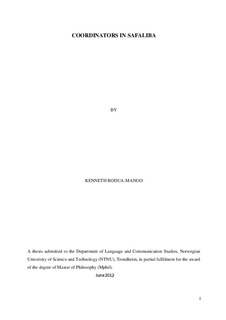| dc.description.abstract | This study examines the Safaliba coordinators „ní‟ / „aní‟, „á‟, „ka‟, „chɛ‟ and „bíí‟ in their naturally occurring environments. Safaliba is a Gur language spoken by some 5000 -7000 people in the north-western part of Ghana.
The main areas of study include the syntactic categories that each coordinator can coordinate, the semantic properties of each of the coordinators and the pragmatic effect that the use of theses coordinators can have. Combinations of the individual coordinators called compound coordinators are also investigated; discussing the syntactic categories that each compound coordinator can coordinate, their semantic contents and the pragmatic effect that the use of each compound coordinator can have. The main source of data is eight (8) selected and transcribed narratives collected during a two month field work carried out between July and August 2010 in Mandari, the largest Safaliba village.
A general background about Safaliba is presented first. Here the language and its people are introduced. Some basic grammatical properties of Safaliba are also presented with the aim of facilitating the reader‟s understanding of various issues as they pertain in Safaliba. These constitute chapters 1and 2.
Secondly, the syntactic properties of the coordinators are investigated. Here, the syntactic categories that each coordinator can coordinate are illustrated with relevant examples. At the end of the discussion on the syntactic properties of these coordinators, I look at whether the coordinators in the language adhere to Payne‟s (1985) implicational scale that is assumed to constrain the syntactic properties of coordinators across languages.
Next the semantic and pragmatic properties of the coordinators are tackled. Here the discussion tries to assign specific meanings to the various coordinators by separating the meanings from connotations that are pragmatically inferred from the use of these coordinators. An attempt to account for the source of the pragmatically derived connotations is also made here.
Last to be discussed are compound coordinators. Here the discussion concerns the definition of compound coordinators and how they are formed. The syntactic categories that each compound coordinator can coordinate are illustrated. Also, specific meaning is assigned to these compound coordinators by separating the pragmatically derived connotations they can carry from the bare meaning of the compounds. | nb_NO |
